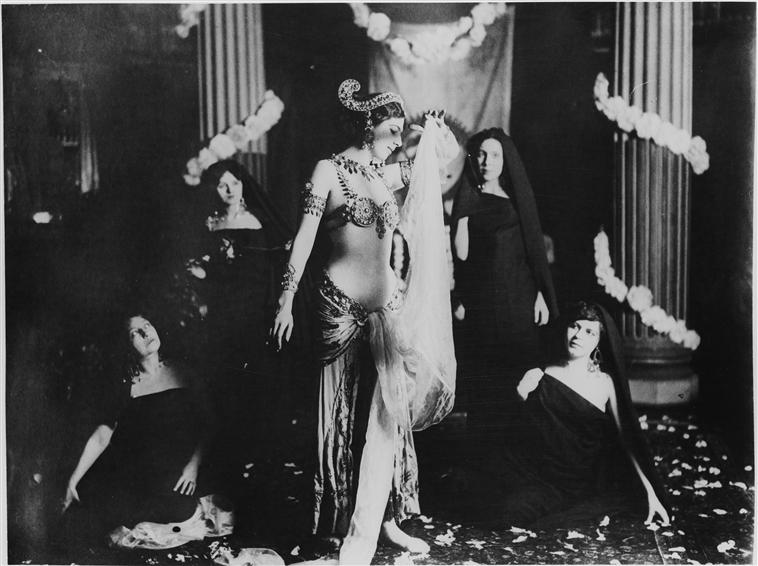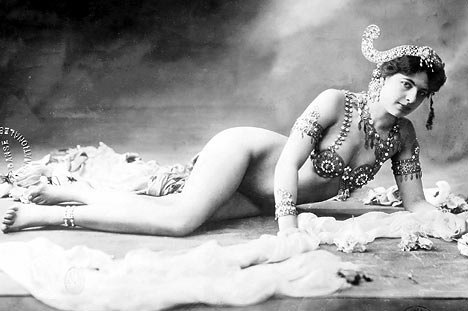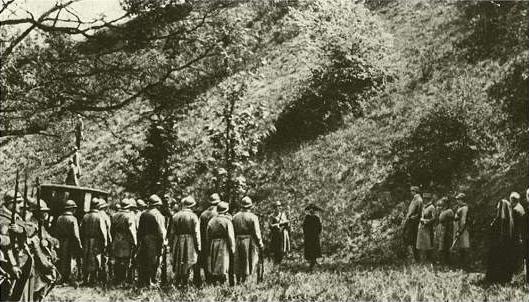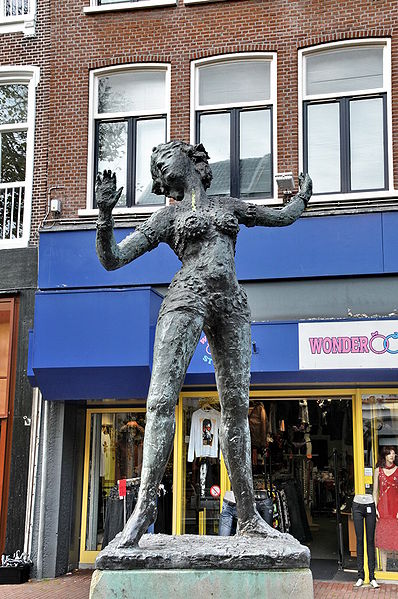<Back to Index>
- Classical Scholar Daniel Albert Wyttenbach, 1746
- Poet Georg Stiernhielm, 1598
- Alleged German Spy Margaretha Geertruida "Grietje" Zelle MacLeod (Mata Hari), 1876
PAGE SPONSOR
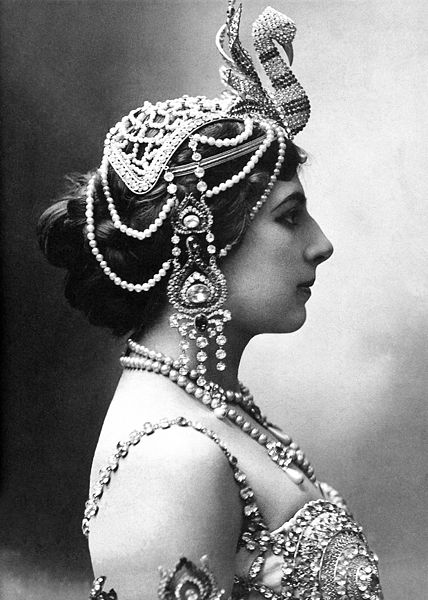
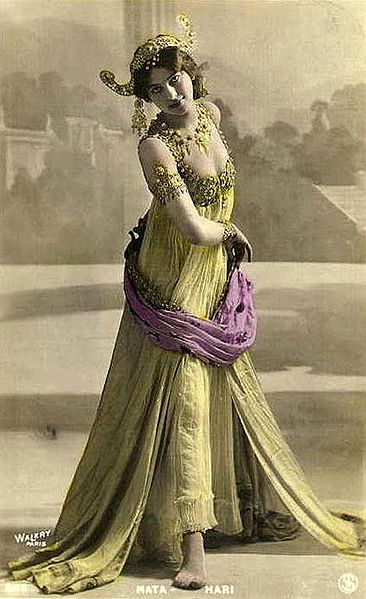
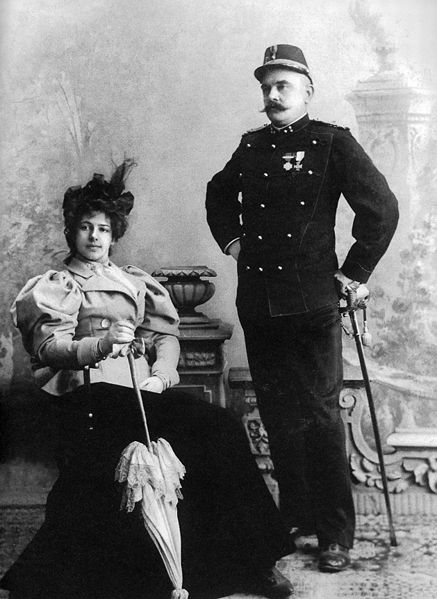
Mata Hari was the stage name of Margaretha Geertruida "Grietje" Zelle MacLeod (7 August 1876, Leeuwarden – 15 October 1917, Vincennes), a Dutch exotic dancer, courtesan, and accused spy who, although possibly innocent, was executed by firing squad in France for espionage for Germany during World War I.
Margaretha Geertruida Zelle was born in Leeuwarden, Friesland in the Netherlands, the eldest of four children of Adam Zelle (2 October 1840, Leeuwarden - 13 March 1910, Amsterdam) and first wife (m. Franeker, 4 June 1873) Antje van der Meulen (21 April 1842, Franeker - 9 May 1891, Leeuwarden). She
had three brothers. Her father owned a hat store, made successful
investments in the oil industry, and became affluent enough to give
Margaretha a lavish early childhood. Thus, Margaretha attended only exclusive schools until age 13. However, Margaretha's father went bankrupt in 1889, her parents divorced soon thereafter, and Margaretha's mother died in 1891. Her
father remarried in Amsterdam on 9 February 1893 to Susanna Catharina
ten Hoove (11 March 1844, Amsterdam - 1 December 1913, Amsterdam), with
whom he had no children. The family had come apart and Margaretha moved
to live with her godfather, Heer Visser, at Sneek. At Leiden,
she studied to be a kindergarten teacher, but when the headmaster began
to flirt with her conspicuously, she was removed from the institution
by her offended godfather. After only a few months, she fled to her uncle's home in The Hague. At
18, she answered an advertisement in a Dutch newspaper placed by a man
looking for a wife. Margaretha married Dutch Colonial Army officer
Rudolf John MacLeod (1 March 1856, Heukelum - 9 January 1928, Velp) in Amsterdam on 11 July 1895. He was the son of John Brienen MacLeod and Dina Louisa Frijherrine Sweerts de Landas. They moved to Java in the Dutch East Indies and
had two children, Norman - John (30 January 1897, Amsterdam - 27 June
1899) and Jeanne - Louise (2 May 1898, Java - 10 August 1919). The marriage was an overall disappointment. MacLeod
was a violent alcoholic who would take out his frustrations on his
wife, who was half his age, and whom he blamed for his lack of
promotion. He also openly kept both a native wife and a concubine.
The disenchanted Margaretha abandoned him temporarily, moving in with
Van Rheedes, another Dutch officer. For months, she studied the Indonesian traditions intensively, joining a local dance company. In 1897, she revealed her artistic name: Mata Hari, Indonesian for "sun" (literally, "eye of the day"), via correspondence to her relatives in Holland.
At
MacLeod's urging, Margaretha returned to him although his aggressive
demeanour hadn't changed. She escaped her circumstances by studying the
local culture. Their son Norman died in 1899 possibly of complications relating to the treatment of syphilis contracted from his parents, though the family claimed he was poisoned by an irate servant. Some sources maintain
that one of Rudolf's enemies may have poisoned a supper to kill both of
their children. After moving back to the Netherlands, the couple
separated in 1902 and divorced in 1906, with Rudolf forcibly retaining
the custody of his daughter (who later died at the age of 21, also possibly from complications relating to syphilis). MacLeod later married twice more. In
1903, Margaretha moved to Paris, where she performed as a circus horse
rider, using the name Lady MacLeod. Struggling to earn a living, she
also posed as an artist's model. By 1905, she began to win fame as an exotic dancer. It was then that she adopted the stage name Mata Hari. She was a contemporary of dancers Isadora Duncan and Ruth St. Denis, leaders in the early modern dance movement, which around the turn of the 20th century looked to Asia and Egypt for artistic inspiration. Critics would later write about this and other such movements within the context of orientalism. Gabriel Astruc became her personal booking agent. Promiscuous,
flirtatious, and openly flaunting her body, she captivated her
audiences and was an overnight success from the debut of her act at the Musée Guimet on 13 March 1905. She became the long time mistress of the millionaire Lyon industrialist Emile Etienne Guimet,
who had founded the Musée. She posed as a Java princess of
priestly Hindu birth, pretending to have been immersed in the art of
sacred Indian dance since childhood. She was photographed numerous
times during this period, nude or nearly so. Some of these pictures
were obtained by MacLeod and strengthened his case in keeping custody
of their daughter. She
brought this carefree provocative style to the stage in her act, which
garnered wide acclaim. The most celebrated segment of her act was her
progressive shedding of clothing until she wore just a jeweled bra and some ornaments upon her arms and head. She was seldom seen without a bra as she was self-conscious about being
small-breasted. Pictures taken during her performances suggest she may
have worn a bodystocking for her shows, as navel and genitals are not seen even in poses where they should be visible on a nude person. Although the claims made by her about her origins were fictitious, the act was spectacularly successful because it elevated exotic dance to
a more respectable status, and so broke new ground in a style of
entertainment for which Paris was later to become world famous. Her
style and her free-willed attitude made her a very popular woman, as
did her eagerness to perform in exotic and revealing clothing. She
posed for provocative photos and mingled in wealthy circles. At the
time, as most Europeans were unfamiliar with the Dutch East Indies and
thus thought of Mata Hari as exotic, it was assumed her claims were
genuine. By
about 1910, myriad imitators had arisen. Critics began to opine that
the success and dazzling features of the popular Mata Hari was due to
cheap exhibitionism and
lacked artistic merit. Although she continued to schedule important
social events throughout Europe, she was held in disdain by serious
cultural institutions as a dancer who did not know how to dance. Mata Hari was also a successful courtesan, though she was known more for her sensuality and eroticism rather than for striking classical beauty.
She had relationships with high-ranking military officers, politicians,
and others in influential positions in many countries, including
Frederick William Victor Augustus Ernest, the German crown prince, who paid for her luxurious lifestyle. Her relationships and liaisons with powerful men frequently took her across international borders. Prior to World War I, she was generally viewed as an artist and a free spirited bohemian, but as war approached, she began to be seen by some as a wanton and promiscuous woman, and perhaps a dangerous seductress. During
World War I, the Netherlands remained neutral. As a Dutch subject,
Margaretha Zelle was thus able to cross national borders freely. To
avoid the battlefields, she travelled between France and the
Netherlands via Spain and Britain,
and her movements inevitably attracted attention. She was a courtesan
to many high ranking allied military officers during this time. On one occasion, when interviewed by British intelligence officers,
she admitted to working as an agent for French military intelligence,
although the latter would not confirm her story. It is unclear if she
lied on this occasion, believing the story made her sound more
intriguing, or if French authorities were using her in such a way, but
would not acknowledge her due to the embarrassment and international backlash it could cause. In January 1917, the German military attaché in Madrid transmitted
radio messages to Berlin describing the helpful activities of a German
spy, code-named H-21. French intelligence agents intercepted the
messages and, from the information they contained, identified H-21 as
Mata Hari. Unusually, the messages were in a code that German intelligence knew had already been broken by the French, leaving some historians to suspect that the messages were contrived. On 13 February 1917, Mata Hari was arrested in her room at the Hotel Plaza Athénée in
Paris. She was put on trial, accused of spying for Germany and
consequently causing the deaths of at least 50,000 soldiers. She was
found guilty and was executed by firing squad on 15 October 1917, at
the age of 41. Pat Shipman's biography Femme Fatale argues
that Mata Hari was never a double agent, speculating that she was used
as a scapegoat by the head of French counter espionage.Georges Ladoux had
been responsible for recruiting Mata Hari as a French spy and later was
arrested for being a double agent himself. The facts of the case remain
vague, because the official case documents regarding the execution were
sealed for 100 years, although, in 1985, biographer Russell Warren Howe
managed to convince the French Minister of National Defense to break
open the file, about 32 years early. It was revealed that Mata Hari was
innocent of her charges of espionage. Mata
Hari's body was not claimed by any family members and was accordingly
used for medical study. Her head was embalmed and kept in the Museum of
Anatomy in Paris, but in 2000, archivists discovered that the head had
disappeared, possibly as early as 1954, when the museum had been
relocated. Records dated from 1918 show that the museum also received
the rest of the body, but none of the remains could later be accounted
for. The
fact that a former exotic dancer had been executed as a spy immediately
provoked many unsubstantiated rumours. One is that she blew a kiss to
her executioners, although it is possible that she blew a kiss to her
lawyer and former lover Edouard Clunet, present at the execution. Her
dying words were purported to be "Merci, monsieur". Another rumour
claims that, in an attempt to distract her executioners, she flung open
her coat and exposed her naked body. "Harlot, yes, but traitor, never,"
she is reported to have said. A 1934 New Yorker article,
however, reported that at her execution she actually wore "a neat
Amazonian tailored suit, specially made for the occasion, and a pair of
new white gloves" though
another account indicates she wore the same suit, low-cut blouse and
tricorn hat ensemble which had been picked out by her accusers for her
to wear at trial, and which was still the only full, clean outfit which
she had along in prison. Neither
description matches photographic evidence. According to an eyewitness
account by British reporter Henry Wales, she was not bound and refused
a blindfold. Wales records her death, saying that after the volley of
shots rang out "...Slowly, inertly, she settled to her knees, her head
up always, and without the slightest change of expression on her face.
For the fraction of a second it seemed she tottered there, on her
knees, gazing directly at those who had taken her life. Then she fell
backward, bending at the waist, with her legs doubled up beneath
her..." A non-commissioned officer then walked up to her body, pulled
out his revolver, and shot her in the head to make sure she was dead.
The
Frisian Museum at Leeuwarden, Netherlands, exhibits a 'Mata Hari Room'.
Located in Mata Hari's native town, the museum is well known for
research into the life and career of Leeuwarden's world famous citizen. The
fact that almost immediately after her death questions arose about the
justification of her execution, on top of rumours about the way she
acted during her execution, set the story. The idea of an exotic dancer
working as a lethal double agent, using her powers of seduction to
extract military secrets from her many lovers fired the popular
imagination, set the legend and made Mata Hari an enduring archetype of
the femme fatale. Much of the popularity is owed to the film titled Mata Hari (1931) and starring Greta Garbo in
the leading role. While based on real events in the life of Margaretha
Zelle, the plot was largely fictional, appealing to the public appetite
for fantasy at the expense of historical fact. Immensely successful as
a form of entertainment, the exciting and romantic character in this
film inspired subsequent generations of storytellers. Eventually, Mata
Hari featured in more films, television series, and in video games -- but increasingly, it is only the use of Margaretha Zelle's famous stage name that bears any resemblance to the real person. Kurt Vonnegut's novel Mother Night is
dedicated to her. Many books have been written about Mata Hari, some of
them serious historical and biographical accounts, but many of them
highly speculative.
